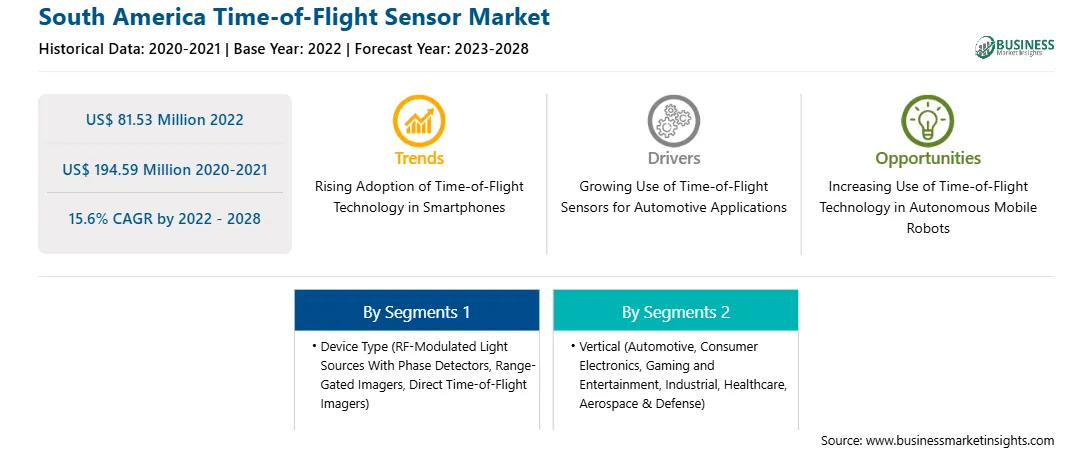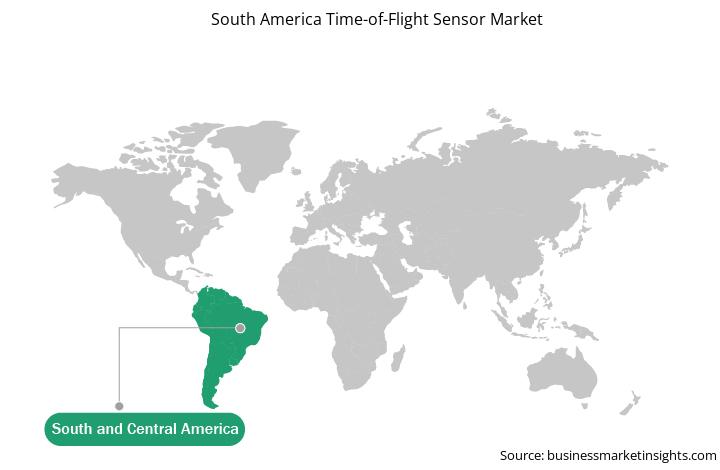The stakeholders across industries are continuously investing in R&D to develop robust solutions to simplify industrial operations. The growing demand for Time-of-Flight Sensors in various industries such as automotive, consumer electronics, and healthcare compelled the market players to invest in developing new and innovative products in recent years. A few of the major product developments are mentioned below:
• In March 2022, STMi croelectronics announced the launch of new high-resolution Time-of-Flight Sensors for advanced 3D depth imaging for smartphones and other devices. The VD55H1 sensor maps 3D surfaces by measuring the distance to around half a million points and helps detect objects up to 5 m from the sensor.
Such advancements in Time-of-Flight Sensors, supported by high investments from manufacturers to develop innovative products as per customer requirements, drive the growth of the South America Time-of-Flight Sensors market.
The Time-of-Flight Sensor market in SAM is segmented into Brazil, Argentina, and the Rest of SAM. The region has a limited number of Time-of-Flight Sensor manufacturers. Among all countries in SAM, Brazil is estimated to be the most significant contributor to the revenue of the market in South America during the forecast period. Most of global automotive companies, including BMW, BYD, Ford, General Motors, Honda, Hyundai, Kia, Land Rover, and Mercedes-Benz, have manufacturing operations in Brazil. The automotive industry accounts for ~15% of Brazil’s industrial GDP. According to Atradius Collections, in the first half of 2021, there was a 33% increase in the registration of new passenger cars in Brazil. Colombia has also seen tremendous growth in the automotive industry, which contributed around US$ 408 million (1.8 trillion Colombian pesos) to the country’s GDP in 2020. Thus, the growing automotive industry in South American countries is propelling the growth of the Time-of-Flight Sensor market.
Strategic insights for the South America Time-of-Flight Sensor provides data-driven analysis of the industry landscape, including current trends, key players, and regional nuances. These insights offer actionable recommendations, enabling readers to differentiate themselves from competitors by identifying untapped segments or developing unique value propositions. Leveraging data analytics, these insights help industry players anticipate the market shifts, whether investors, manufacturers, or other stakeholders. A future-oriented perspective is essential, helping stakeholders anticipate market shifts and position themselves for long-term success in this dynamic region. Ultimately, effective strategic insights empower readers to make informed decisions that drive profitability and achieve their business objectives within the market.

| Report Attribute | Details |
|---|---|
| Market size in 2022 | US$ 81.53 Million |
| Market Size by 2028 | US$ 194.59 Million |
| Global CAGR (2022 - 2028) | 15.6% |
| Historical Data | 2020-2021 |
| Forecast period | 2023-2028 |
| Segments Covered |
By Device Type
|
| Regions and Countries Covered | South and Central America
|
| Market leaders and key company profiles |
The geographic scope of the South America Time-of-Flight Sensor refers to the specific areas in which a business operates and competes. Understanding local distinctions, such as diverse consumer preferences (e.g., demand for specific plug types or battery backup durations), varying economic conditions, and regulatory environments, is crucial for tailoring strategies to specific markets. Businesses can expand their reach by identifying underserved areas or adapting their offerings to meet local demands. A clear market focus allows for more effective resource allocation, targeted marketing campaigns, and better positioning against local competitors, ultimately driving growth in those targeted areas.

The South America Time-Of-Flight Sensor market is segmented on the basis of device type, vertical, and country. Based on device type, the South America time-of-flight sensor market is segmented into RF-modulated light sources with phase detectors, range-gated imagers, and direct time-of-flight imagers. The range-gated imagers segment registered the largest market share in 2022.
Based on vertical, the South America time-of-flight sensor market is segmented into automotive, consumer electronics, gaming and entertainment, industrial, healthcare, aerospace and defense, and others. The consumer electronics segment registered a larger market share in 2022.
Based on country, the South America time-of-flight sensor market is segmented into Brazil, Argentina, and the Rest of SAM. Brazil dominated the market share in 2022.
Analog Devices Inc, Infineon Technologies AG, InvenSense Inc, Keyence Corp, OMRON Corp, Panasonic Holdings Corp, Sony Group Corp, STMicroelectronics NV, Teledyne e2v (Overseas) Holdings Ltd, and Texas Instruments Inc are the leading companies operating in the South America time-of-flight sensor market.
The South America Time-of-Flight Sensor Market is valued at US$ 81.53 Million in 2022, it is projected to reach US$ 194.59 Million by 2028.
As per our report South America Time-of-Flight Sensor Market, the market size is valued at US$ 81.53 Million in 2022, projecting it to reach US$ 194.59 Million by 2028. This translates to a CAGR of approximately 15.6% during the forecast period.
The South America Time-of-Flight Sensor Market report typically cover these key segments-
The historic period, base year, and forecast period can vary slightly depending on the specific market research report. However, for the South America Time-of-Flight Sensor Market report:
The South America Time-of-Flight Sensor Market is populated by several key players, each contributing to its growth and innovation. Some of the major players include:
The South America Time-of-Flight Sensor Market report is valuable for diverse stakeholders, including:
Essentially, anyone involved in or considering involvement in the South America Time-of-Flight Sensor Market value chain can benefit from the information contained in a comprehensive market report.